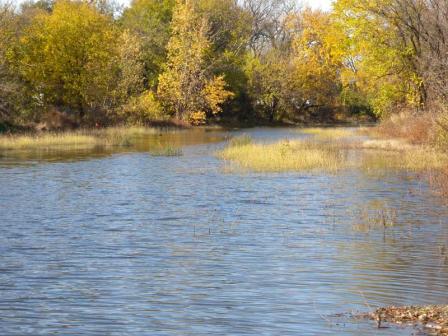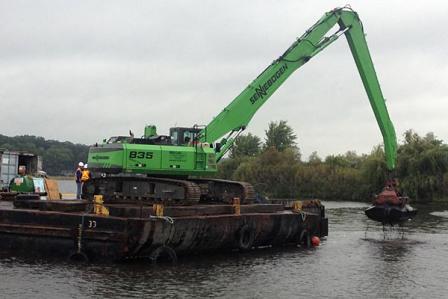Restoring the AOCs
- What is the process for restoring AOCs?
- Who does the work and what plan do they follow?
- How is the restoration work funded?
- How do we measure progress/results?
 Restoration of the Grand Calumet River in Indiana
Restoration of the Grand Calumet River in Indiana
What is the process for restoring AOCs?
The process for removing Beneficial Use Impairments and delisting AOCs starts with a scientific assessment by the state and federal agencies to determine the extent to which beneficial uses are impaired and the types of management actions required to remediate the AOC. After management actions are implemented, a monitoring and verification plan may be implemented by the state agency, the local public advisory council, EPA and others to determine whether the BUI removal criteria have been met. An AOC is eligible to be delisted when all BUIs have been removed.
Who does the work and what plan do they follow?
The Remedial Action Plan includes management actions necessary for delisting. These are the reasonable and realistic actions that could be taken to remove the relevant BUIs and thus delist the AOC. These actions may not result in the immediate removal of a set of BUIs, but they are expected to remove the contaminant threat that will allow environmental conditions to improve over time and lead to eventual delisting of the AOC.
All management actions necessary for delisting are considered implemented once those actions have commenced and the work is completed over the life of the project. For example, a Legacy Act dredging project that takes place over a 6-month period would be considered a completed management action at the end of that 6-month period.
How is the restoration work funded?
The Great Lakes Restoration Initiative (GLRI), established in 2010, is providing significant resources to remediate and restore the Great Lakes. From 2010-2014, over $2.2 billion has been spent on implementing Great Lakes restoration projects. Of that, over $700 million has been devoted to AOC-related projects.
 Removing contaminated sediment from White Lake in Michigan.
Removing contaminated sediment from White Lake in Michigan.
EPA provides direct funding for the RAP program to the state agency charged with implementing the AOC program. The state agency then distributes those funds to local groups to implement the AOC program.
Within the AOC program, EPA has the lead in removing BUIs and delisting AOCs. Under GLRI, EPA works with other federal agencies to develop and implement programs and fund the states and other local entities to remove BUIs and delist AOCs. Accordingly, EPA manages an ongoing budget and planning cycle with a key group of federal agencies (NOAA, FWS, US Army Corps of Engineers, USGS) to ensure that agency resources are devoted to meeting this goal.
EPA determines which agency is best able to implement projects based upon their resources and expertise. EPA and these agencies meet on a regular basis and, in conjunction with yearly state agency meetings, plans and budgets are developed that allocate the resources.
How do we measure progress/results?
The federal government created the Interagency Task Force (IATF) which consists of 11 federal agencies collaborating to identify and fund projects. In 2010, the IATF created the GLRI Action Plan that charted a course to address the most pressing Great Lakes problems and set targets to show progress to improve environmental conditions. The GLRI Action Plan II Exit, updated in 2014, has identified two measures of success for the AOC program:
- AOCs where all management actions necessary for delisting have been implemented
- AOC BUIs removed
Progress as of 2015
- delisted four AOCs:
- removed 56 BUIs out of 255
- completed management actions at three other AOCs
Removing BUIs
The process to remove a BUI is:
- Complete all management actions necessary to achieve the BUI removal criteria;
- Collect the needed data to show the target is met and recommend BUI removal;
- Draft data is shared with EPA and it undergoes internal review via EPA and other agency experts. If needed, EPA and the state contacts discuss the data and conclusions.
- EPA comments are shared with the State indicating whether EPA concurs that the target has been met.
- State and local groups conduct public outreach, offer a public comment period, and acquire local group endorsement of the BUI removal.
- State submits the BUI removal request to the Director of the EPA’s Great Lakes National Program Office (GLNPO).
- GLNPO Director receives request and, if acceptable, approves the BUI removal request.
Delisting
In 2001, the US Policy Committee for the Great Lakes published Restoring United States Areas of Concern: Delisting Principles and Guidelines, which outlined the steps to delist an AOC. The 2012 Great Lakes Water Quality Agreement (GLWQA) provides new guidance on how to delist an AOC.
EPA maintains a tracking program to measure results and to inform all relevant parties on the progress in achieving the goals outlined in the GLRI Action Plan II. Exit
During 2015-2019, federal agencies will coordinate with the appropriate level of government to provide funding to:
- implement critical management actions in the remaining AOCs and
- complete management actions required to delist these ten AOCs:
- Buffalo River
- Clinton River
- Grand Calumet River
- Manistique River
- Menominee River
- Muskegon Lake
- River Raisin
- Rochester Embayment
- St. Clair River
- St. Marys River
